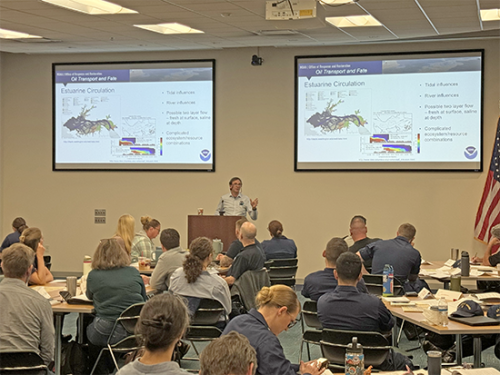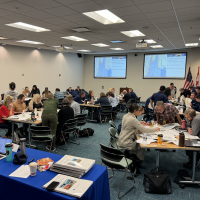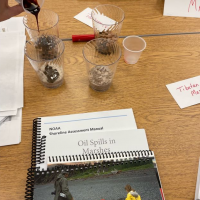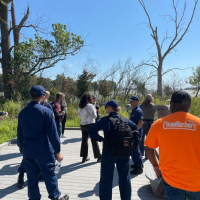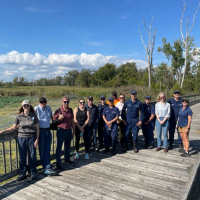NOAA Trains Spill Responders and Planners on Science of Oil Spills in Michigan
SEPT. 30, 2024 — During the week of September 16, 50 spill responders and planners gathered at the Great Lakes Environmental Research Laboratory in Ann Arbor, Michigan for a Science of Oil Spills (SOS) class hosted by NOAA’s Office of Response and Restoration (OR&R).
Participants represented agencies and organizations across the Great Lakes and the U.S., and were a mix of U.S. Coast Guard (USCG) pollution responders and managers, Environmental Protection Agency (EPA) On-Scene Coordinators (OSCs), federal and state environmental managers, tribal representatives, and industry partners.
The SOS class taught oil chemistry, water and oil physical transport processes, air and water sampling, shoreline ecology, oil toxicological effects, marsh and beach sensitivities and natural processes, shoreline and on-water recovery and treatment options, and the scientific and legal processes for making treatment decisions.
In addition to core content taught by NOAA OR&R, some additional topics were taught by guest instructors, including:
- Tricia Edwards and Jon Gulch, EPA Region 5 OSCs, who presented on air sampling and spill response in rivers and streams. As a case study, they reviewed the Kalamazoo Line 5 pipeline spill, in which a 30-inch oil pipeline ruptured near Marshall, Michigan in July 2010, contaminating Talmadge Creek and the Kalamazoo River with hundreds of thousands of gallons of diluted bitumen.
- John Nelson, U.S. Department of the Interior Regional Environmental Officer, who presented on National Historic Preservation Act consultation and the inadvertent discovery process for cultural artifacts.
- Jerry Popiel, USCG District 9 Incident Management and Preparedness Advisor, Co-chair of the CANUSLAK Joint Contingency Plan, and Regional Response Team 5 Co-chair, who presented on Endangered Species Act consultation and CANUSLAK. CANUSLAK (Canada-United States Great Lakes) refers to the operational annex to the bilateral Joint Marine Pollution Contingency Plan between the United States and Canada, established to ensure coordinated planning, preparedness, and response to a harmful substance incident in the contiguous waters of the two nations.
- Kevin Bott, Environmental Quality Analyst with Michigan Department of Environment, Great Lakes, and Energy, who presented on water sampling.
- James Kessler, Great Lakes research oceanographer, who presented on water circulation modeling in the Great Lakes.
Participants gained a deeper understanding of the various topics presented through the expertise of the scientists involved and the comprehensive information they provided.
more images






 An official website of the United States government.
An official website of the United States government.

